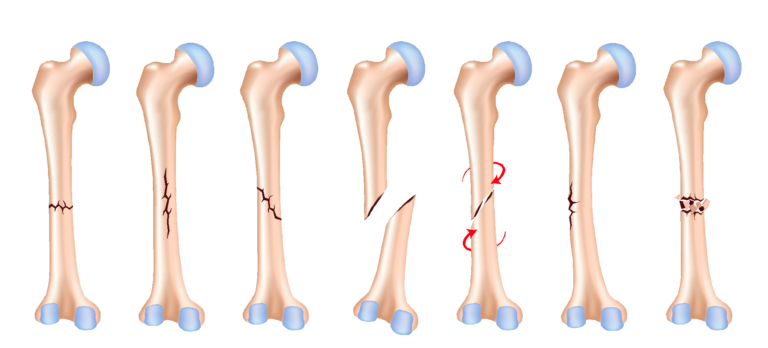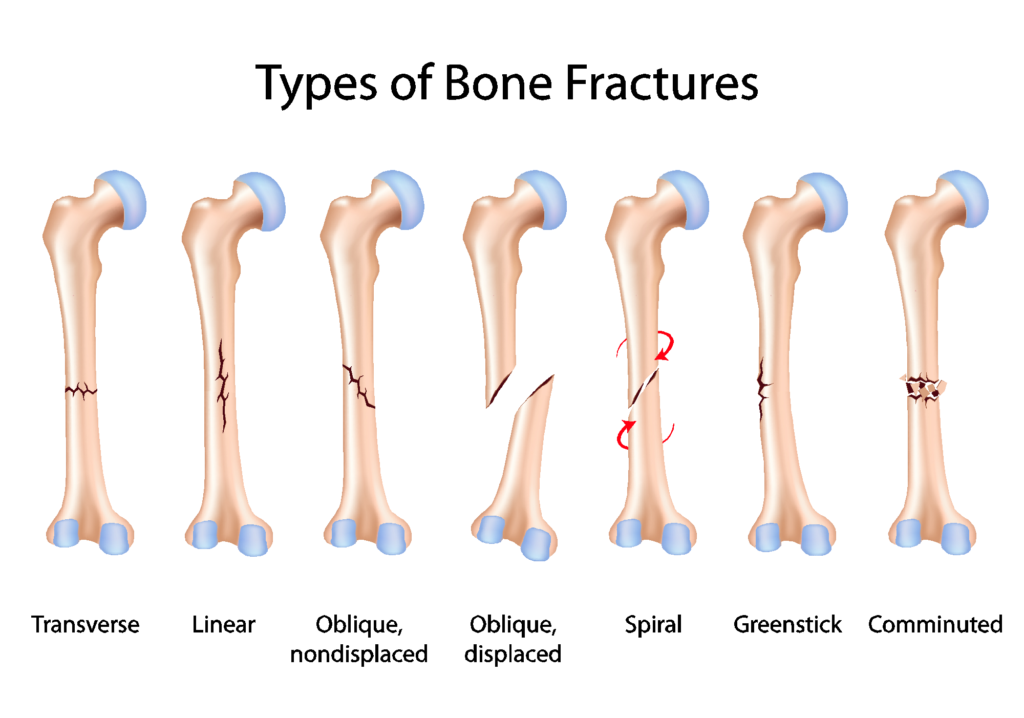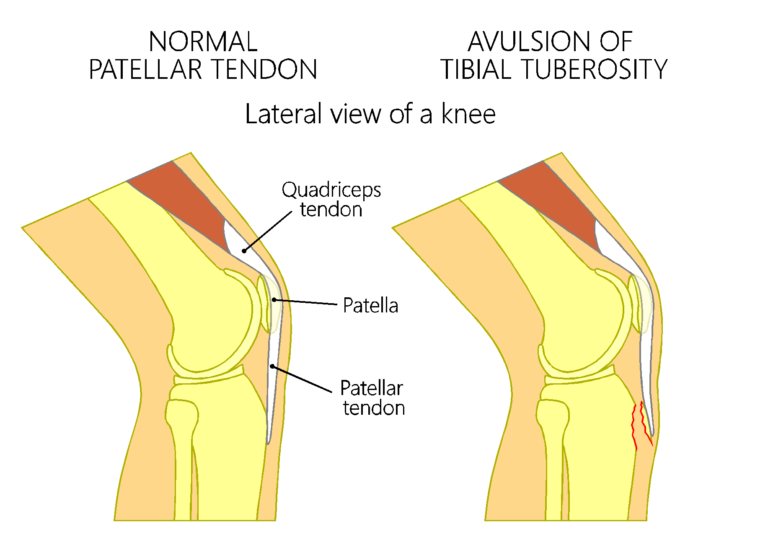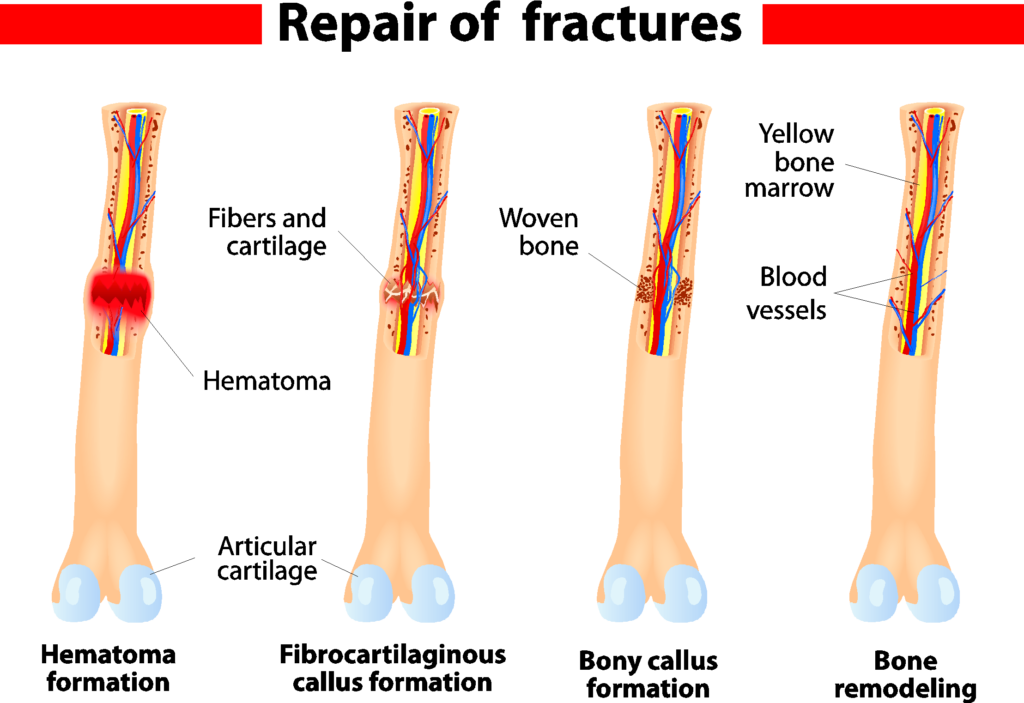Bone Fractures

Fractures consist of a breakdown of the bone structure either due to trauma or repetitive stress.
The following includes examples illustrating which excessive forces result in specific types of fractures.


Transverse Fracture: Excessive bending
Linear Fracture: May result from numerous excessive forces including direct impact
Oblique Fracture: Excessive bending
Spiral Fracture: Excessive twisting
Greenstick Fracture: Excessive bending
Comminuted Fracture: Bone breaks into several pieces
Avulsion Fracture: Straight pulling (traction) of a tendon or ligament on a bone
Compression Fracture (Torus/Buckle Fracture in children): Direct loading, crushing, or compression
Stress Fracture (Fatigue Fracture): Repetitive microtrauma
Fracture Treatment
Fractures often follow a very predictable progression of healing. When recovering from a fracture, you will likely go through 2 primary phases in the rehabilitation process.
Phase 1
The first involves of period of immobilization, where you will likely be provided with a cast, brace, splint, and/or specific instructions on movement restrictions.
During this phase the broken bone is going through the process of healing.

After a bone breaks, bleeding around the fracture site occurs. The blood then begins to clot in order to help stabilize the bone as well as provide the framework necessary to produce new bone. Over time the blood clot is replaced by fibrous tissue and cartilage, which is then eventually replaced by new hard bone.
Once your physician is confident that your fracture has healed, he or she will likely discontinue the cast, splint, or brace and will update your movement restrictions.
The total time for a bone fracture to fully heel on an XRAY varies from person to person based on numerous factors including the age and general health of the individual, as well as the type and location of the fracture.
In general however, it is common to see children heal within 4-6 weeks, adolescents within 6-8 weeks, and adults within 10-18 weeks. Keep in mind that these are just general guidelines, and your physician will be able to provide a much more specific time frame for your individual case.
Phase 2
Once the bone appears to be radiographically healed, or your physician determines you have undergone sufficient healing based on other markers, you will enter into the next phase of healing known as the post-immobilization phase.
During the following several weeks and months your bone will undergo additional remodeling. But remember that just because the fracture has healed on the XRAY does not mean that the strength of your bone has fully returned.
It is during this phase that physical therapy is often helpful, as a gradual and carefully designed load bearing, strength, and aerobic training program will assist in optimizing the strength of the newly formed bone.
In addition, it is very common to experience a loss of joint mobility as well as muscle strength and flexibility surrounding the region of the fracture after the removal of the cast, splint, brace, or other movement restrictions that were prescribed during the immobilization phase.
Physical therapy will work on regaining optimal joint mobility and muscle flexibility and strength in a manner that is simultaneously beneficial to enhancing bone strength.
TAKE ACTION!
- If you believe you have undergone a bone-related injury, be sure to consult with a licensed healthcare provider specializing in this field in order to receive a definitive diagnosis rather than attempting to “guess and test.”
- If you have been diagnosed with a fracture, be sure to follow your physician’s guidelines carefully in order to allow for sufficient radiographical (XRAY/CT Scan) healing.
- Upon your physician’s clearance, begin focusing on restoring bone strength as well as joint mobility, muscle strength, and flexibility surrounding the region of the fracture.
- If you have not done so already, please be sure to read the following article on enhancing bone health and recovery:

Bones
Bones provide the basic shape and framework of our body, protect internal and vital organs, and allow for movement by proving an attachment for muscles. On this page you will learn exactly what causes bone injury, the process of healing after bone injury, and how to ultimately enhance the health and performance of your bones.
Summary
Bone fractures are a break in the bone structure that results from excessive stress placed upon the bone. There are two primary phases of the recovery process after a bone fracture. The first phase focuses on allowing for sufficient healing of the bone structure. The second phase consists of focusing on regaining bone strength, as well as joint mobility and muscular strength and flexibility.

Dr. Eugene Ketselman PT, DPT, Cert. MDT, CSCS
Dr. Eugene Ketselman is a licensed Physical Therapist, Certified Strength and Conditioning Specialist, Performance Coach, and owner of Convergent Movement and Performance; Home of where Physical Therapy, fitness, and performance training converge! Dr. Ketselman's mission is to help motivated athletes and active adults excel in their passions by maximizing physical performance and reducing setbacks from pain and injury.
Here at Convergent Movement and Performance, we practice what we preach. You know we are a good match for one another as soon as you find yourself relating to the content we provide. Be sure to click below to learn more.
Do you have specific questions that aren’t answered on this website?
Click below
Does pain, weakness, or exhaustion prevent you from reaching your FULL potential while performing the activities you love?
Click below
Do you love what you’re seeing, but still aren’t sure if you can make the commitment?
Click below
Contact Us
Convergent Movement and Performance serves out of Northern – Central New Jersey, conveniently located to those that live, work, and travel in the nearby towns of Warren, Bridgewater, Martinsville, Watchung Hills, Bedminster, Basking Ridge, Bernardsville, Chatham, Westfield, and Piscataway within Somerset, Morris, Union, and Middlesex counties, NJ.
